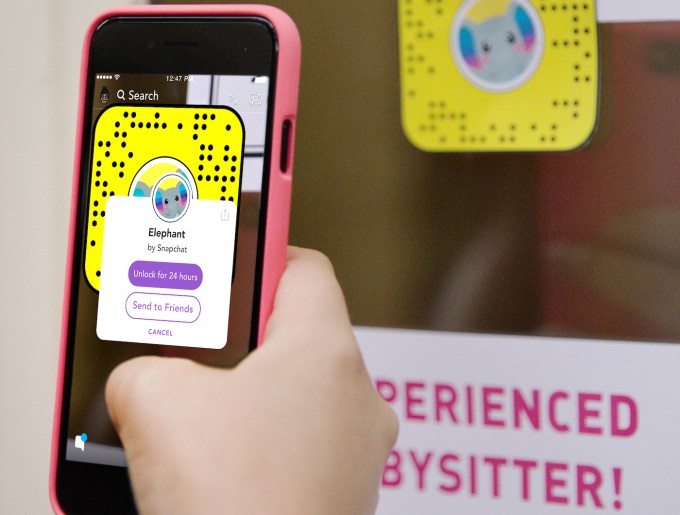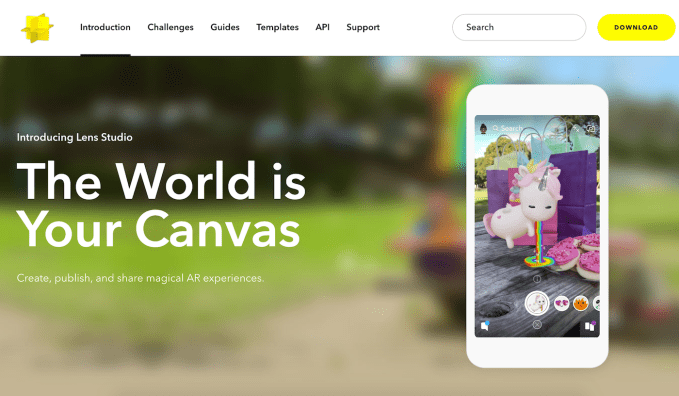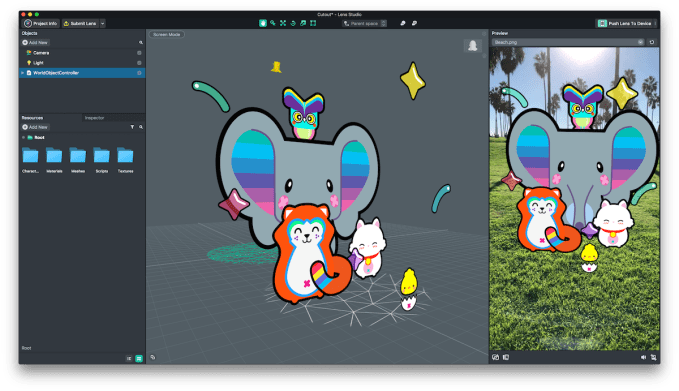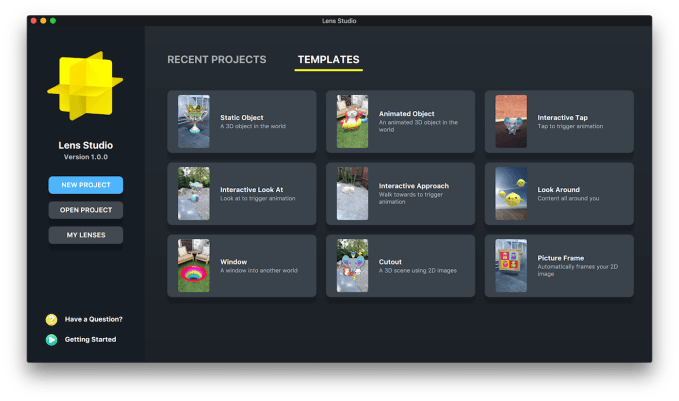Snapchat is finally opening up so outside developers can help it offer infinite augmented reality experiences beyond those it designs in-house. Today, Snap launches the Lens Studio AR developer tool for desktops so anyone can create World Lenses that place interactive, imaginary 3D objects in your photos and videos.
But brands, news publishers and developers will have to promote their own Lenses by marketing their QR Snapcodes that users scan to unlock an AR effect for 24 hours. That’s because Snapchat won’t display these Community Lenses in its camera unless businesses pay a partnered creative agency to build them a special effect and then buy Sponsored Lens ads from Snap.
The launch could vastly broaden Snapchat’s AR entertainment value, helping it to compete with Facebook’s own Camera Effects AR platform that launched to all developers early this week. Though for now the platform only lets you make World Lenses and not selfie masks, more AR toys will give Snapchat a much-needed boost to sharing and viewing at a time when user growth has slowed to a trickle in the face of Instagram’s competition.

Snap already sees one-third of its 178 million daily users play with Lenses each day for an average of 3 minutes, which adds up to 500 years of playtime with AR each day. And that’s just with the 3,000 Lenses Snap has made itself. With the opening of the platform, Snap’s VP of engineering and camera platform leader Eitan Pilipski tells me, “There’s something magical about coming back every day and finding that there’s a new experience.”
By removing its in-house AR design team as a bottleneck through agency partnerships, Snap could scale up augmented reality advertising so it doesn’t miss its quarterly revenue target again.

The launch is a wise move. Back in April I wrote that “Snap’s anti-developer attitude is an augmented liability,” discussing how filling the real world with AR was too tall of a task for Snap to tackle on its own. It needed an army of outside developers to assist it, and now it’s recruiting that army. The question is whether developers see the audience scale in Snapchat necessary to validate investing time into the platform, and whether Snap provides enough unpaid access to that audience. Because to move the needle on growth, Snapchat needs the AR brainchildren of more than just slimy marketers slapping brands atop the virtual world.
Create, test, share with Lens Studio
Starting today, anyone can download the Lens Studio desktop app for Mac or Windows in English and visit its website for examples and documentation. Lens Studio is a slightly stripped down version of what Snap’s own team uses to build AR experiences. It’s designed for simplicity, so anyone from 2D Photoshop newbies to experienced 3D animators and coders can jump into making basic image overlays or reactive AR characters. Developers retain ownership of Lenses they create, though grant Snapchat the right to use them.

Developers can build static or animated objects, 2D cutouts, windows into other worlds, floating picture frames and even 3D objects that react when you tap, look at or approach them. Developers can get a temporary Snapcode to test their creation on their phones. After going through a quick moderation process to make sure the Lens isn’t objectionable, developers get a Snapcode that’s valid for a year, which they can share via social media, their websites, print materials or however they want to get the word out.
Snapchat’s moderators will enforce rules stating that Lenses can’t depict violence, weapons, nudity, sex acts, profanity, hatred, stereotypes, illegal activity, hashtags, usernames, threats, bullying or encourage Snapping while driving. Snapchat tells me it will have a report button for users who need to flag Lenses as problematic, and a human moderation team will monitor reports and deactivate offending Lenses. It will have to keep a watchful eye, though, as the vividness of AR could make for a big PR scandal if kids start playing with something graphic.

Snapchat also plans to offer Lens Studio Challenges, where it will provide an unspecified reward for developers who create Lenses that match a proposed theme or use case. They might just get recognition on the new Lens Studio website, but if Snapchat is smart, it will actually release the winners in its app to drive developer interest in the platform.
Scan, unlock and augment with Lens Snapcodes
While users can still find the curated assortment of Lenses within the Snapchat camera, they’ll now be able to discover Community Lenses elsewhere. By tapping and holding on a Lens Snapcode in view of their camera or uploading a screenshot, they’ll get a thumbnail preview of what the Lens does and the option to unlock it. They’ll then see the Lens in their carousel in the camera for 24 hours. Tapping a little “i” information button reveals who made the Lens, and users can send one to a friend via private chat so Lenses can go viral.
The 24-hour limit could prove annoying as users might not want to go through the chore of rescanning codes every day. On the other hand, it could discourage overuse of a specific lens, preventing burnout amongst a creator’s friends and viewers. Pilipski says Snapchat will be listening to the community to evolve the experience. But one advantage is that developers can update a code to provide a different Lens so they could incrementally evolve it over time or provide different experiences without having to promote a different code.
Overall, the initial crop of AR experiences look cute and on-brand for Snapchat’s goofy style. We’ll see if the dancing hot dog that was viewed 1.5 billion times was a blockbuster because of the novelty of AR, or whether users will enduringly want to play with 3D characters.
Pay, build and advertise with Lens Studio partners
Snapchat has partnered with seven Lens Studio firms to outsource creation of its AR experiences. Avatar Labs, Fisherman Labs, Haus, Media Monks, North Kingdom, Trigger Global and Vidmob can be paid to create a Lens in just a few days instead of the weeks it used to take Snapchat’s internal team, which also required a $300,000 minimum ad spend. Now brands can buy CPM distribution of their Snapchat Lens in the camera app’s carousel for an $8 to $20 CPM.
Snapchat’s in-house design team will still work with advertisers, but will focus on super premium campaigns using the most cutting edge technology options that go beyond Lens Studio’s capabilities.

Snapchat has been a closed company since its inception, relying on the instincts and curation of CEO Evan Spiegel. But here, Snapchat is changing its strategy to embrace what it can’t entirely control. That unpredictability may be the key to keeping the app fresh. As much as Snapchat is the arbiter of cool from its Venice Beach offices in LA, it can’t foresee every weird teen trend or toy, let alone build them itself.
By opening the platform, Snap can let the community do the trial-and-error for it. Snapchat should both learn from what Community Lenses prove popular and build more like them, but also promote those that are a hit rather than forcing developers to grow an audience on their own. It’s the promise of potential virality that turned Facebook into a platform powerhouse 10 years ago, spawning giants like Zynga. Now Snapchat’s path forward depends on it being willing to share its users and the credit for entertaining them.
